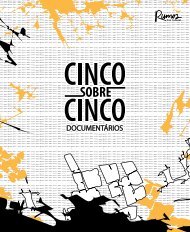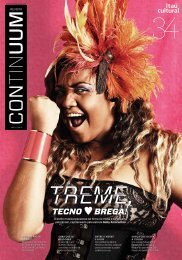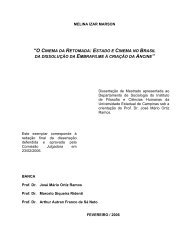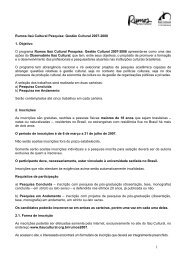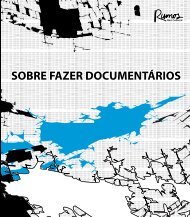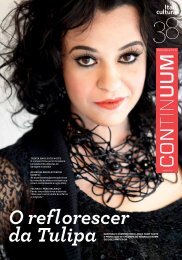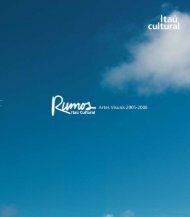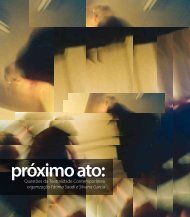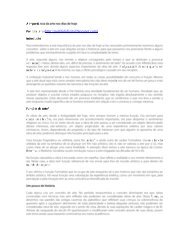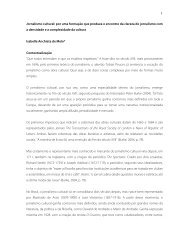PatrÃcia Moran - Itaú Cultural
PatrÃcia Moran - Itaú Cultural
PatrÃcia Moran - Itaú Cultural
You also want an ePaper? Increase the reach of your titles
YUMPU automatically turns print PDFs into web optimized ePapers that Google loves.
Esses pontos de aproximação ainda guardam uma distânciacom as performances que podem acontecer nas noiteslisérgicas das raves, em festivais de arte ou galerias. No Brasil,festivais de arte eletrônica e digital como o Videobrasil e o Filee eventos como o RedBull Live Images e o On_Off têm abrigadode maneira ideal performances audiovisuais. Entendemoscomo forma ideal aquela que possibilita à imagem vida própria,ou melhor, em que ela é a protagonista, não estando areboque do som. Esses eventos merecem atenção, pois sãoideais em termos da organização do espaço físico, adaptadoàs necessidades de cada performance e/ou à multiplicidadede telas que propicia a criação de ambientes imersivos.A linha de força que nos interessa neste artigo privilegia aimagem abstrata. Em tese, toda imagem pode ser consideradaabstrata por se tratar de uma mediação, uma apresentaçãopossível do mundo e de seus objetos. Quando falamosem imagem figurativa, estamos nos referindo àquela quemostra objetos, traz a marca do mundo material, ou seja,guarda semelhança com o referente. Já na abstração estamospensando na ausência de referente. Caso haja referente,como veremos no trabalho de Eder Santos e Luiz Duva, eleestá tão marcado por sobreposições, tão tratado em termosde cores e luzes e tão distorcido por aproximações como ozoom que não há qualquer possibilidade de se localizar visualmenteuma referência no mundo das coisas. Podem-seimputar semelhanças, mas estas são da ordem do desejo deproduzir encadeamentos e valores significantes na imagemprojetada e em sua forma em evolução, ou seja, no movimento.O visível é potência pura, é virtualidade, é alusão aalgo que não se realiza como figuração. O visível não oferecequalquer garantia de correspondência com objetos concretos,sua relação primeira é com a imagem mesma.These approximation points are still not enough to bridgethe gap with the performances that may take place in thelysergic evenings in rave parties, art festivals, or galleries. InBrazil, digital and electronic art festivals such as Videobrasiland File and other events like RedBull Live Images and On_Offhave ideally provided a shelter to audiovisual performances.By ‘ideal’, we understand the form that enables the image tohave its own life, namely, a life in which it plays the majorrole rather than being towed by sound. These events deserveattention for they are ideal in the sense of organization of thephysical space, adapted to the needs of each performanceand/or the multiple screens that provide good conditions tocreate immersing environments.The force line of our interest in this article places emphasis onthe abstract image. In theory, every image can be consideredabstract because it is a type of mediation, a likely presentationof the world and its objects. When we talk about a figurativeimage, we are referring to the one depicting objects,bringing the sign of the material world, namely, bearing aresemblance to the referent. In abstraction, in turn, we areconsidering the absence of such referent. Should there be areferent, as we will see in Eder Santos’s and Luiz Duva’s work,it is so marked by superimpositions, so treated with respectto colors and lights, and so distorted as a result of zoomingin, that there is no way to visually pinpoint a reference in theworld of things. Similarities can be imputed, but their natureis that of the desire to produce strings and meaningful valuesin the image projected and in its form of evolution, i.e., in themotion. Being visible is pure power, is virtuality, is allusion tosomething that is not materialized as figuration. The visibleaspect does not ensure any correspondence with concreteobjects, its primary relation is that with the image itself.Three poetic strategies of audiovisual performances will bediscussed here. The first one, dominant in Brazil, is based onthe mixture of figurative image banks – or bases – as loopingsare usually called — short films — taken in HDs. VJ Spetto,Desconstrução, Embolex, Aléxis Anastasiou, and Maxifagia(the new name of the Bijari collective group with onemember less) are examples of artists that use mixture as thesustaining pillar of their work. The second one has an abstractimage as its final product, it starts with elements created orTrês estratégias poéticas de performances audiovisuais serãoaqui tratadas. A primeira, dominante nas pistas do Brasil,tem por base a mistura de bancos de imagens figurativas, oubases, como se costuma nomear os loopings — filmes curtos— levados nos HDs. VJ Spetto, Desconstrução, Embolex,Aléxis Anastasiou e Maxifagia (novo nome do coletivo Bijaricom um integrante a menos) são exemplos de realizadoresque sustentam seu trabalho na mistura. A segunda tem porproduto final uma imagem abstrata, parte de elementos criadosno computador ou não, mas o resultado predominantesão gráficos, ou melhor, formas. Exemplos são VJ 1mpar,Raimo Benedetti, Nacho Duran, entre outros. Finalmente,no terceiro grupo vamos trazer trabalhos dos artistas EderSantos e Luiz Duva. Na grande diferença dos dois há em comuma destruição da imagem para a construção de um bailadovisual barroco.O sentido de segunda ordemA performance audiovisual contemporânea em geral e os VJsem particular devem sua existência à miniaturização da tecnologiae aos bancos de dados, um dos grandes facilitadoresda cultura remix. Com a miniaturização de computadoresportáteis, laptops e o barateamento de projetores configuraseuma condição de trabalho que já designamos em outraocasião como artesanato digital. Artesanato, entre outras razões,pelo fato de o realizador cuidar de todo o processo decriação imprimindo sua assinatura no talhe da imagem.Em um laptop conectado à rede cabem todas as imagensdo mundo: fixas ou em movimento, silenciosas ou ruidosas.Produções para a grande circulação em televisões e cinemas,trabalhos experimentais, filmes científicos, imagens de vigilânciacaptadas por corporações ou voyeurs, vídeos domésticosde âmbito pessoal ou documentação do mundo. Osrealizadores, sejam eles inicialmente cineastas, sejam artistasde videoinstalações, performances ou single channels, em algummomento do seu trabalho se utilizam do repertório domundo. Temos ainda a reutilização do repertório próprio comum gesto remix. Uma imagem utilizada em um filme voltaem uma videoinstalação, como fez a cineasta Agnès Varda.Imagens captadas originalmente para um vídeo institucionalsão uma videoarte com Eder Santos. Peter Greenaway reutilizaas imagens produzidas para seus filmes em performancesaudiovisuais. A cultura do excesso de imagens, do excesso deinformações e do excesso de estímulos é um laboratório demisturas do banco de dados.Tomamos emprestado de Roland Barthes 1 a leitura do mitocomo sistema significante construído a partir de um sentidoexistente, para ler as performances audiovisuais e a culturaremix. “A língua (ou os modos de representação que lhe sãonot in the computer, but the prevailing outcome are graphs,that is, shapes. Examples can be found in VJ 1mpar, RaimoBenedetti, Nacho Duran, and others. Lastly, the third groupwill encompass works by artists Eder Santos and Luiz Duva.Within the large difference between the two, the destructionof the image to build a Baroque visual dance choreographyis the common point.The second-order meaningContemporary audiovisual performance, in general,and VJs, in particular, owe their existence to technologyminiaturization and databases, one of the factors that havegreatly contributed to pave the way for the remix culture.Miniaturization of portable computers, laptops, and the dropin the price of projectors provide working conditions for whatwas previously referred to as digital handicraft. Handicraft,among other reasons, because the artist takes care of thewhole creative process, so that ultimately, the image designcarries his own signature.A laptop connected to the web can hold all images inthe world: still or moving, silent or sound. Productions forlarge-scale dissemination by means of television channelsand movie theaters, experimental works, scientific films,surveillance images captured by corporations or voyeurs,personal home-made videos or world documentation. Artists,either filmmakers, at first, or artists of video installations,performances or single channels, utilize the world’srepertoire some time in their work. In addition, we see there-utilization of the artist’s own repertoire accompanied by aremix gesture. An image used in a film comes back in a videoinstallation, as filmmaker Agnès Varda did. Images originallycaptured for an institutional video become video art in EderSantos’s hands. Peter Greenaway re-uses images producedfor his films in audiovisual performances. The culture of theexcess of images, excess of information, and the excess ofstimuli is a laboratory of mixed databases.We borrow from Roland Barthes 1 the reading of the mythas a signifier system built on an existing meaning in orderto read the audiovisual performances and remix culture.“The language (or the modes of representation which are80 81
comparados) chamarei de linguagem-objeto, porque é a linguagemde que o mito se serve para construir o seu própriosistema; e o próprio mito, chamarei metalinguagem, porqueé uma segunda língua, na qual se fala da primeira” (p. 206). Aleitura do mito em Barthes tem eco em outros autores queproblematizam a sobrecodificação da arte e da informaçãonos dias de hoje. Arlindo Machado, em Arte e Mídia, 2 entendea arte como metalinguagem da mídia (p. 17). Para LevManovich, 3 o remix — mistura de imagens, estruturas artísticase sociais, e estruturas de pensamento — está na lógica docapitalismo tardio (cf. p. 26). O antropólogo e documentaristaJean-Louis Comolli, ao pensar como deve se dar a relaçãodo documentarista com o mundo, alerta para a necessidadede o realizador estabelecer estratégias que fujam de roteirosjá traçados, ou seja, ao mundo sobrecodificado, ao sentidoestandardizado. 4 Autores com projetos teóricos tão distintostêm em comum o entendimento de que estamos em umacultura em que a produção do sentido se dá a partir de umsentido preexistente, uma espécie de conhecimento de domíniocomum em certas esferas da cultura urbana. Comopano de fundo, essas colocações apontam a voracidade dacultura contemporânea na produção e circulação da arte ede informações em geral. O real, quando representação domundo nos trabalhos audiovisuais, traz uma história pregressa,dialoga com outra forma expressiva, seja ela da comunicação,seja da arte.***Exemplo máximo do remix são os VJs de pista, realizadorescom trajetória marcadamente noturna. Spetto 5 é no Brasil oVJ típico desse espaço. Com o programa Flash, desenvolveuo aplicativo VR Studio MX, para realizar misturas de suas performances.Atualmente, trabalha com software proprietáriocom seu laptop conectado a diversas interfaces MIDI, comoos brinquedinhos Mixman DM2, câmeras de vigilância, umaluva para acionar e distorcer bancos de dados. Chamar asinterfaces de Spetto de brinquedinho não é uma metáfora,esse mixer é de plástico barato e seu custo não chega aos100 dólares. A estrutura técnica dos VJs, ou rider, é importante,pois tem uma relação direta com a performance, com otipo de imagem produzida.assimilated to it), which I shall call the ‘language-object’,because it is the language which myth gets hold of in orderto build its own system; and myth itself, which I shall callmetalanguage, because it is a second language, in whichone speaks about the first.” Barthes’ reading of myth finds anecho in other writers who question the overcodification ofart and information in the present days. Arlindo Machado, inhis Arte e Mídia, 2 understands art as a media metalanguage(p. 17). For Lev Manovich, 3 the remix — a mixture of images,art and social structures, and structures of thought — lies inthe logic of a belated capitalism (cf. p. 26). Anthropologistand documentarian Jean-Louis Comolli, when thinkingabout how the relation between the documentarian andthe world should be, draws the attention to the need for thedocumentarian to design strategies that avoid falling intostep with widely-known scripts, i.e., the overcodified world,standardized meaning. 4 Writers with such distinct theoreticalprojects coincide in understanding that we are in a culturewhere the production of meaning is effected by resortingto a preexistent meaning, a sort of common knowledgewithin certain realms of urban culture. As a backdrop, theseassertions pinpoint contemporary culture’s ravenousnessto produce art and information, in general, and keep themmoving. The true aspect, as a representation of the worldin audiovisual works, carries an earlier history, engagesin a dialog with another form of expression, be it either ofcommunication or art.***The utmost remix example are the dance floor VJs, artists witha chiefly night career. In Brazil, Spetto 5 is the typical VJ of thistype of space. With his Flash program, he developed the VRStudio MX application to mix his performances. Presently, heworks with proprietary software with his laptop connected toa diversity of MIDI interfaces, such as little toys Mixman DM2,surveillance cameras, a glove to start and distort databases.Calling Spetto’s interfaces ‘little toys’ is no metaphor. Thismixer is made of cheap plastic and its cost does not exceed100 dollars. The VJs’ technical structure, or rider, is importantfor they are directly related to the performance, with the typeof image produced.Os trabalhos do início da trajetória de Spetto, por volta de2000, eram metanarrativas. Traziam imagens sobrecodificadas,com endereçamentos de sentido prontos. O personagemda ficção mexicana Chaves e George Bush, ex-presidentedos Estados Unidos, lutavam na projeção de Spetto. Sena economia os Estados Unidos sobrepujam o México, o VJinverte essas forças. As cores fortes e a moldura em volta dospersonagens, como nas histórias em quadrinhos, quebramvisualmente a reverência da dominação político-econômica.O problema de Estado ganha cores e moldura de quadrinhosproduzindo um efeito cômico. Atualmente, as performancesde Spetto não têm lançado mão de ícones tão marcados.Ao contrário, há um processo de esgotamento da figuraçãoprovocado pelo excesso, pela profusão de imagens, pelosbrancos que piscam sobre e entre as imagens. Em alguns casos,6 a velocidade de encadeamento, ou seja, de sucessão, étamanha que é inútil tentar se deter em um frame, guardaruma figura, pois a performance vale como um todo, comoexperiência de estar circundado por traços e formas em movimento.A figuração se desmaterializa e traz uma dimensãodo conhecimento ainda não consolidada, que se anuncia aopensamento, mas ainda é informe, indeterminada, aberta,segundo a semiótica peirciana. Trata-se de uma qualidadeexpressa como movimento, cor e textura. Estamos no campodas intensidades. O olho marcado pelo branco da luz tambémpisca contribuindo para a abstração da imagem.O sentido em suspensãoA prevalência de estímulos que privilegiam ritmos e de umaênfase em associações formais pouco ou nada codificadasestá no trabalho de Raimo Benedetti e de Nacho Duran. 7 Asperformances estruturam a própria matéria do fazer, comoa cor, a textura, o grão e o pixel. A poética dos dois é quaseoposta em termos de infraestrutura técnica.Benedetti trabalha com uma tecnologia muito simples, a saber:projetor, câmera de vídeo e televisão montados no queele denomina Trakitana, espécie de mesa, table top usada nocinema para animação em geral. O artista substitui a câmeracinematográfica pela de vídeo e, no lugar das cartelas oudesenhos a serem animados, coloca uma televisão ligada aum videocassete com suas bases. Os controles de velocidade,escala e cor da câmera são recursos da performance. ASpetto’s early works, when he started his career around2000, were metanarratives. They contained overcodifiedimages with ready-to-use meaning addressing. The MexicanTV character The Kid From The 8 and George Bush, formerpresident of the United States, were fighting in Spetto’sscreening. If in economic terms the United States outdoMexico, the VJ shows those two powers the other way round.The strong colors and the frame around the characters, justlike in comic strips, visually break the political and economicdomination worship. The State issue is given colors and acomic-strip frame results in a comic effect. Nowadays, Spetto’sperformances have not resorted to such strong icons. On thecontrary, a process of figuration exhaustion is underway, asa consequence of the excess, the profusion of images, thewhite points blinking on and between the images. In somecases, 6 the speed of the stringing process, i.e., the successionis so fast that it is useless to try to watch a single framelonger, to keep a picture, because the performance pays offas a whole, for the experience of being surrounded by linesand shapes in motion. The figuration dematerializes itselfand opens the way to a dimension of knowledge not yetconsolidated, which announces itself to thought, althoughstill shapeless, indeterminate, open, according to Peirce’ssemiotics. This has to do with quality expressed as motion,color, and texture. We are in the realm of intensities. The eyemarked by the whiteness of the light also blinks to contributeto image abstraction.Suspending meaningBoth stimuli favoring rhythms and an emphasis on barelycodifiedor non-codified formal associations are seen toprevail in Raimo Benedetti’s and Nacho Duran’s works. 7The performances structure the very matter of doing, suchas color, texture, grain, pixel. The poetics of both of themis nearly opposite to each other with regard to technicalinfrastructure.Benedetti works with unsophisticated technology, such as: aprojector, a video and television camera mounted on whathe calls Trakitana, a sort of tabletop used in filmmaking foranimation, in general. The artist replaces the cinema camerawith a video camera and, instead of the titles or drawingsbeing animated, he puts a television set connected to a VCR82 83
produção das bases também é simples materialmente. Paraa criação de seus gráficos e figuras geométricas utiliza oPaintbrush, programa simples oferecido pela Apple no pacotebásico do computador, para imagens fixas. Nesse caso, suamanipulação consiste em retirar cores e aproximar as figurasdesenhadas. A câmera varre a tela, percorre a superfície daimagem da televisão, segue linhas, desenha percursos, revelasempre o mesmo: uma linha a se percorrer. A música deXabier Erkizia, com quem ele realiza esse trabalho, enfatiza asmarcações cíclicas da imagem.Benedetti trabalha com ciclos. O release de sua performancea coloca como um concerto em quatro movimentos.Conhecedor de ópera e música clássica, ele costuma seapresentar com maestros em concertos tradicionais. Suaperformance visual traz da música a abstração, a circularidadedos temas, uma espécie de ritornelo, entendido aquialém da repetição, como momento da música em que háum retorno do coro. No trabalho de Benedetti a temporalidadeestabelece ciclos e repetições. A repetição de pontos,de cada vez mais pontos, mas não a repetição do mesmo. Oritmo instaurado pela repetição pressupõe uma variação, avariação visível é de quantidade. Subjacente à quantidade,instala-se nova qualidade com os ciclos. Algo muda em ciclos,algo muda discreto, é o rastro na imagem, é o aumentodos círculos. O concerto ao qual estou me referindo integroua programação do On_Off, no Itaú <strong>Cultural</strong>. Simples e engenhoso,o segundo movimento do concerto era composto degotas, uma evolução delas. A base técnica das mesmas é orecurso scroll de programas de edição; o scroll, assim como atable top, foi originalmente desenvolvido para a animação deletreiros, para criar movimentos verticais ou horizontais doscréditos. Benedetti lança mão do scroll mas, em vez de letraspercorrendo verticalmente a tela, há uma dança de pontosfinais. Uma bola branca sobe pela tela e repete o movimentodeixando um rastro. A quantidade de bolas cresce e diminuiseu tamanho. Nesse trabalho, temos o desenho a emular amúsica na marcação temporal.A performance de Santos conta no palco com uma “caixa”de telas dentro da qual as atrizes Maria Luísa Mendonça eMônica Ribeiro se revezam na leitura e encenação bastanteposada de um texto nonsense. Não fosse a força das imagensprojetadas e o diálogo da música de Josefina Cerqueira ePaulo Santos com as atrizes, haveria o risco de a performancetransformar-se em um evento teatral. Os sons, os ruídos eas vozes estão em toda parte. Os corpos irrompem gritando.A baixa resolução da tela e a sobreposição da imagem dasatrizes com a projeção não nos autoriza a humanizar aquelescorpos. São vultos, são pulos, são formas femininas com lonwithits bases. The controls of the camera speed, scale andcolor are performance features. The production of the basesis also simple in material terms. For the creation of his graphsand geometric figures, he uses Paintbrush, a simple programprovided by Apple in a basic computer package for stillimages. In this case, his manipulation consists in removingcolors and approaching the drawn figures to each other. Thecamera scans the screen, goes through the television imagesurface, follows lines, draws circuits, always reveals the same:a line to go through. The music of Xabier Erkizia, his partner inthis venture, emphasizes the cyclic image indications.Benedetti works with cycles. His performance press releaseputs it as a four-movement concerto. A connoisseur of operaand classical music, he performs together with conductorsin traditional concerts. His visual performance takes frommusical features like abstraction, theme circularity, a type ofritornello, which is understood here to go beyond repetition,as a moment in the piece of music in which there is a recurrentpassage for the chorus. In Benedetti’s work, temporality setscycles and repetitions. The repetition of points, increasinglymore points, not the repetition of the same, though. Therhythm triggered by the repetition makes one assume theexistence of a variation, the visible variation refers to quantity.Underlying such quantity, a new quality is established withthe cycles. Something changes in cycles, something changesdiscreetly, it is the image track, it is the increase in circles. Theconcerto I am referring to took part in the On_Off programheld at Itaú <strong>Cultural</strong>. Simple and ingenious, the concertosecond movement was composed of drops, an evolutionof drops. Their technical base is the scroll feature in editingprograms; the scroll, just like the tabletop, was originallydeveloped for title animation to create vertical or horizontalmovements of credits. Benedetti resorts to scroll but, insteadof letters running the screen vertically, it shows a dance ofperiods. A white ball climbs up the screen and repeats themotion leaving a track. The number of balls increases whiletheir size reduces. In this work, the drawing emulates themusic piece according to the marking of tempo.In the previous performances mentioned, abstraction resultsfrom saturation, it is in the organization of the expressiveelements, in the superimposition and juxtaposition of materialNas performances anteriormente mencionadas, a abstraçãoé resultado da saturação, está na organização dos elementosexpressivos, na sobreposição e justaposição material e desentidos, de registros sonoros e visuais, enfim, vem do excesso.Aqui os elementos utilizados já são abstratos, a imageme o ritmo rarefeitos: estamos diante da temporalização daimagem, de uma performance sustentada pela sucessão, porciclos audiovisuais.No outro extremo, em termos tecnológicos, o espanhol radicadoem São Paulo Nacho Duran realiza suas performancesora com o aplicativo Randox, por ele desenvolvido, ora comPure Data (PD), linguagem de programação com respostaem tempo real. A programação costuma ser realizada porFernando Velásquez, uruguaio também residente no Brasil.A abstração criada é próxima à de linguagens semelhantes,antecessoras da PD, como o Max_jitter, desenvolvimentodo lendário Nato. 8 A performance de Duran explora principalmenteo quadro e a decomposição das formas, recursorecorrente nessas linguagens. No Randox, como sugere onome do aplicativo, serão geradas combinações aleatórias,ou seja, randômicas; com o PD, as imagens escorrem segundoprogramação em tempo real, com o descontrole humanodos processos autogenerativos.A potência da explosãoFinalmente, faremos uma rápida passagem pelas performancesA Place Where No Cars Go, de Eder Santos, e Concerto paraLaptop: Sem Título, de Luiz Duva, conhecido como VJ duVa.Interessa-nos como esses trabalhos transformam o eventoem pura potência. Quando dizemos potência nos referimosa uma força irregular em termos de frequência. Se nas performancesde Benedetti havia harmonia na repetição, aqui háirregularidade. A potência também está nas explosões quepontuam os espetáculos.and meanings, of sound recording and footage, to sum up, itresults from excess. Here, the elements utilized are abstract tostart with, the image and the rhythm are scarce: we are beforethe image temporalizing, before a performance sustained bysuccession, by audiovisual cycles.On the other end, in technological aspects, Spanish artistliving in Sao Paulo Nacho Duran makes his performances byusing either the Randox application, which he developed,or Pure Data (PD), a programming language with realtimeresponse. The programming is usually carried out byFernando Velásquez, a Uruguayan also living in Brazil. Theresulting abstraction is close to that of similar languages, PD’spredecessors, such as Max_jitter, developed by legendaryNato. 8 Duran’s performance explores particularly the frameand the decomposition of shapes, a recurrent feature of theselanguages. In Randox, as the application name suggests, theoutcome is focused on generating random combinations;with PD, the images flow according to real-time programmingwith the human decontrol of autogenerative processes.The power of explosionLastly, we shall catch a sight of the performances A Place WhereNo Cars Go, by Eder Santos, and Concerto para Laptop: SemTítulo, by Luiz Duva, a.k.a. VJ duVa. Our interest lies in how theseworks turn the event into pure power. By mentioning power,we are referring to an irregular power as far as frequency isconcerned. While in Benedetti’s performances the repetitiontook place in harmony, in this case, it is uneven. The power isalso seen in the explosions scattered throughout the shows.Santos’s performance presents on the stage a “box” of screensinside of which actresses Maria Luísa Mendonça and MônicaRibeiro take turns reading and acting out a nonsense textwith strong emphasis on poses. Were it not for the strengthconveyed by the images projected and the dialog of JosefinaCerqueira’s and Paulo Santos’s music with the actresses, theperformance could run the risk of being transformed into atheatrical event. The sounds, the noises, and the voices areeverywhere. The bodies burst into yelling. The low screenresolution and the superimposition of the actresses’ imagewith the projection do not empower us to humanize thosebodies. They are figures, they are hops, they are long-haired84 85
gos cabelos. Entre imagens, literalmente entre imagens, elasse deitam, ficam em pé, tentam voar como pássaros.As imagens projetadas na caixa não elucidam a cena. Figurasgráficas do bestiário do contista Murilo Rubião dançam emvolta das atrizes na caixa. Vale lembrar que o texto lido porelas mistura o conto O Ex-mágico da Taberna Minhota, deRubião, com textos da equipe da performance. Em outrosmomentos, nuvens e bolhas ocupam o espaço da sala. A caixa,a tela de plasma no meio da sala, tudo flutua, o brancodas imagens se destaca na tela negra da caixa, na sala escura.O branco flutua como o sentido, que não encontra, oumelhor, que não busca um lugar. Aqui há uma evanescênciade relações de significação em prol da afecção. Permanece apotência do choque de estímulos em menos de meia horade espetáculo. Nessa performance, atrizes, músicos e imagensproduzem durante os 20 e poucos minutos de duraçãoestímulos diversos, que estouram sem avisar ao espectadorsua origem, sua sucessão, o lugar do próximo grito, do próximosom, da próxima luz. Os diversos recursos expressivos seestruturam e estruturam uma profusão de estímulos que seautoanulam. Permanecem frases poéticas incompletas, abertas.Os movimentos são ao mesmo tempo bruscos e suaves.Bruscos pela maneira como irrompem e suaves na evolução.Nuvens, gráficos e bolhas emolduram o palco e falsamentecriam uma unidade.Em duVa, a potência e o estouro se instauram também emcerca de 20 minutos de espetáculo, mas aqui há uma economiaformal de recursos expressivos. Como o título daperformance anuncia, trata-se de um Concerto para Laptop.Conectado ao projetor, ele expõe um corpo a explosões, achoques contra a parede. Corpo? Ainda corpo, apesar daspoucas curvas, das poucas formas, da pouca humanidadepresente na imagem. É no som, na batida seca do corpobranco, que se incorpora uma dimensão humana à cena. Obranco do corpo não é apenas atributo da pessoa que estáem cena, é também piscada do programa Isadora, utilizadopelo realizador. Concerto para Laptop radicaliza a desumanizaçãoiniciada com a performance Suspensão nº 1, apresentadano On_Off. Nesse trabalho, o artista estava só no palcocom seu laptop. Nu, levantava-se e pulava diante de umacâmera que enviava o sinal ao Isadora. Os telões projetavamfemale shapes. Amongst images, literally amongst images,they lie down, stand up, try to fly like birds.The images projected in the box do not elucidate the scene.Graphic figures from short-story writer Murilo Rubiao’s bestiarydance around the actresses in the box. It is worth mentioning,that the text they read is a mixture of the short-story O Exmágicoda Taberna Minhota, by Rubiao, and texts writtenby the performance crew. Some other times, clouds andbubbles fill the room space. The box, the LCD in the middleof the room, everything drifts, the whiteness of the imagesstands out against the black screen of the box in the darkroom. The whiteness floats just like the meaning, which doesnot find, or better saying, does not look for a place. Here thesignification relations vanish to the benefit of affection. Thepower of the stimulus shock remains in less than half an hourof show running. In this performance, actresses, musicians,and images produce, during the twenty or more minutes oflength, a variety of stimuli, which blow up without letting theviewer know their origin, their succession, the site of the nextyell, of the next sound, of the next light. The several expressivefeatures structure themselves and structure a myriad of stimulithat promote self-nullification. What remains are incompleteand open poetic phrases. The motions are, at the same time,sudden and gentle. Sudden for they happen unexpectedly,and gentle as they evolve. Clouds, graphs, and bubbles framethe stage and falsely create unity.In duVa, the power and the blow-out also take place in about20 minutes of show. Here, however, expressive features areformally saved. As the performance title announces, this is aConcerto para Laptop [Concerto for laptop]. Wired togetherwith a projector, it exposes a body to explosions, to shocksagainst a wall. A body? Still, a body, despite the few numberof curves, the lack of shapes, the little humanity in the image.A human dimension is incorporated into the scene throughsound, through the harsh hitting of the white body. Thewhiteness of the body is not only an attribute of the personacting on the scene, but it also comes from the Isadorasoftware used by the artist. Concerto para Laptop radicalizesthe dehumanization initiated with the performanceSuspensão nº 1, exhibited at the On_Off. In this work, the artistwas alone on stage with his laptop. Naked, he would stando corpo magro e branco cruzando a tela. O corpo quase sedissolve como imagem, mas ainda há figuração.As performances de duVa em tempo real, com manipulaçãode imagens ao vivo, sempre contaram com a suspensão domovimento como recurso expressivo e, nesse caso, contaramtambém com a suspensão do tempo. Suas apresentações noespetáculo Vermelho Sangue são neste sentido exemplares.Na época em que concebeu e realizou a performance, duVaainda utilizava o software de edição Final Cut. Mesmo emum programa como esse, ele nunca abriu mão do branco naimagem, do branco entre frames, do branco aparente comoforma auxiliar na suspensão do movimento e, logo, na expectativade mudança da imagem, de conclusão de seu tempo.Aqui raramente há um movimento regular, como visto no cotidiano.Estamos diante de um movimento tensionado pelamanipulação do realizador. Movimento nervoso com inícioe fim, sem meio. Trata-se de um movimento-tensão, não deuma síntese do movimento, como buscaram as artes da representaçãoda imagem em movimento. Esse traz potência.Abrupto, pula, nos oferece saltos e voos duros, são cortes. Emseu site, duVa sintetiza o espetáculo como um “ensaio poéticoque parte da livre interpretação de diferentes paisagensemocionais”. As distintas paisagens propostas pelo realizadorsão para nós um lugar da potência, do indefinido, do vago,como alguns sentimentos.***Como chamamos atenção no início do texto, seja com imagensfigurativas em velocidade, seja com outras, abstratas,criadas graficamente, ou ainda pela abstração resultante daaproximação em escala com sua matéria, uma linha de forçade imagens pouco codificadas se consolida. É muito simplistaestabelecer uma relação de causalidade entre a sobrecodificaçãoda cultura urbana e a suspensão do sentido coma abstração. Mas uma questão permanece: estaremos sendoconvocados a recuperar um olhar livre de endereçamentos?Uma vez perdida a inocência do olhar, dificilmente ela podese recuperar, mas a suspensão do sentido pelo nonsense, asubstituição das imagens pelo ruído e o movimento, o apagamentoda figuração pelo excesso podem estar anunciandoum refúgio para a percepção, uma resposta positiva, eup and hop in front of a camera that was sending the signalto Isadora. The large-sized screens projected the slenderand white body moving across the screen. The body nearlydissolves as an image, while figuration still persists.DuVa’s real-time performances, by manipulating images live,have always counted on motion suspension as an expressivefeature and, in this case, also counted on time suspension. Hisperformances in the show Vermelho Sangue are exemplary inthis regard. At the time when such performance was conceivedand shown, duVa was still using the Final Cut editing software.Even though using a software like that, he had never leftbehind the whiteness on the image, the whiteness betweenframes, the apparent whiteness as an auxiliary form to suspendmotion and, therefore, in the expectation to change theimage, to fulfill its time. Here, there is rarely a regular motionas seen on a day-to-day basis. We are placed before a motionstretched by the artist’s manipulation. The nervous motionwith a beginning and an end and no middle part. This is amotion-tension, not a motion synthesis, as the arts related tomoving image representations have sought to achieve. Thisone is powered. Abrupt, it hops, it provides jumps and hardflights; they are cuts. In his web site, duVa synthesizes the showas a ‘poetic essay which is based on the free interpretationof different emotional landscapes.’ The different landscapesproposed by the artist are, for us, a place of power, of theindefiniteness, the vagueness, such as some feelings.***As we pointed out in the beginning of this text, be it eitherwith figurative images at speed or with other images,abstract, graphically created ones, or else, the abstractionresulting from the approximation to its matter in scale, a lineof force of image scarcely codified consolidates. It is a verysimplistic approach just establishing a cause relation betweenthe urban culture overcodification and the suspension ofmeaning with abstraction. Nevertheless, an issue persists:are we being called to recover a look free from addressingcodes? Once naïveness is gone from the look, chances arevery little that one can win it back, but meaning suspensionby nonsense, the replacement of images for noise andmotion, the vanishing of figuration deriving from excess may86 87
não tomada pelo medo da imagem. Esta linha de força nãodeveria amedrontar, o objeto exterior não desaparece, elecontinua onde está. E nas performances, sem qualquer totalidadeou redenção, imagens sem verdade brincam de formasanimadas, de poesia e música.Patrícia <strong>Moran</strong>Doutora em comunicação e semiótica pela Pontifícia UniversidadeCatólica de São Paulo. Professora do curso de audiovisual da Escolade Comunicações e Artes da Universidade de São Paulo, divide suaatuação profissional entre o ensino, a criação audiovisual e a pesquisaacadêmica. Seus trabalhos foram exibidos e premiados em mostras efestivais nacionais e internacionais. Conclui a pesquisa A Metáfora dosSentidos, sobre as performances em tempo real dos VJs.Notas1. barthes, Roland. Mitologias. Rio de Janeiro: Difel, 2003. pp. 204-7.2. machado, Arlindo. Arte e mídia. Rio de Janeiro: Jorge Zahar, 2007.3. manovich, Lev. Software takes command. Versão de 20 de novembrode 2008 do livro em fase de elaboração e já colocado na rede. Cf.www.softwarestudies.com/softbook para versão mais recente dolivro. O autor problematiza a lógica do remix. Como é um livro emprocesso, esse ponto é colocado como um problema. Mas os argumentosainda estão em fase de maturação. Não cabe, aqui, adentrara discussão, pois a questão metodológica a ela ligada não é o nossofoco. A título de nosso trabalho, entender o remix como um dado dacultura contemporânea é o suficiente.4. comolli, Jean-Louis. “Sob o risco do real”. In: Catálogo do Forumdoc.bh. 2001 – 5º Festival do Filme Documentário e Etnográfico. BeloHorizonte, 2001.5. www.visualradio.com.br.6. Há artistas que prezam a imagem como sentido, porém não vamosnos deter neles neste artigo. Mas ainda quando vale o sentido,na grande maioria dos casos ele está repleto de nonsense, de nãodito e de sugestões.7. No artigo “Cintilâncias”, publicado na revista Galáxias, editada pelaCOS_PUC, discutimos performances gráficas. Aqui, vamos nos restringira esta rápida passagem pelos realizadores supracitados.8. Na revista de arte espanhola a Mínima, número 22, Barcelona,2007, Mia Makela, ou VJ SOLU, entrevista Johnny DeKam sobre aslinguagens que desde o final dos anos 1990 têm possibilitado o trabalhoem tempo real com parâmetros da imagem. Eles têm a enormevantagem de se adaptar às necessidades de cada performance.Vale a menção a esses recursos, pois no Brasil ainda é pequeno onúmero de realizadores que definem uma plataforma tendo em vistaa possibilidade de alterar seus parâmetros.be foretelling a refuge for perception, a positive response,and not struck by the fear of image. This line of force shouldnot be frightening. The external object does not disappearfor it remains where it is. And the performances show, withneither entirety nor redemption, images without a truth thatplay animated shapes of poetry and music.Patrícia <strong>Moran</strong>She holds a doctor’s degree in communication and semiotics fromthe Sao Paulo Pontifical Catholic University. She is a professor inthe audiovisual course of the School of Communications and Arts,University of Sao Paulo. Professionally, she also devotes her time toteaching, audiovisual creation, and academic research. Her workshave been exhibited and received awards in and from national andinternational film showings and festivals. She has completed herresearch titled A Metáfora dos Sentidos, on VJs’ real-time performances.Notes1. barthes, Roland. Mythologies. New York, Hill and Wang, 1984.(extracted from http://www.artsci.wustl.edu/~marton/myth.html]2. machado, Arlindo. Arte e mídia. Rio de Janeiro: Jorge Zahar, 2007.3. manovich, Lev. Software takes command. Version as of November 20,2008, from the book being prepared and available online. Cf. www.softwarestudies.com/softbook for the latest version of the book. Thewriter questions the remix logic. As the book is still being prepared,this topic is mentioned as a problem, the arguments of which arestill being considered, though. There is no point here in discussing itfurther, as the methodological issue connected to it is not our focus.For the matter of this work, understanding remix as a contemporaryculture datum suffices.4. comolli, Jean-Louis. “Sob o risco do real”. In: Catálogo do Forumdoc.bh. 2001 – 5º Festival do Filme Documentário e Etnográfico. BeloHorizonte, 2001.5. www.visualradio.com.br.6. There are artists that appreciate image as meaning. However,we shall not go into details about them in this article. But, as faras meaning is concerned, in a vast majority of cases it is full ofnonsense, things not said, and suggestions.7. In the article “Cintilâncias”, published in Galáxias magazine byCOS_PUC, graphic performances are discussed. Here, we shall limitour analysis to a general overview of the aforementioned artists.8. In the Spanish art magazine Mínima, number 22, Barcelona, 2007,Mia Makela, or VJ SOLU, interviews Johnny DeKam on languages thatsince the late 1990s have enabled the work with image parametersin real time. They offer this enormous advantage of adapting to theneeds of each performance. It is worth pointing out these featuresbecause the number of artists in Brazil that choose a platform basedon the possibility to change its parameters is very low.O Lugar Aonde os Carros Não Vão, de Eder Santos | foto Cia de Foto88 89



